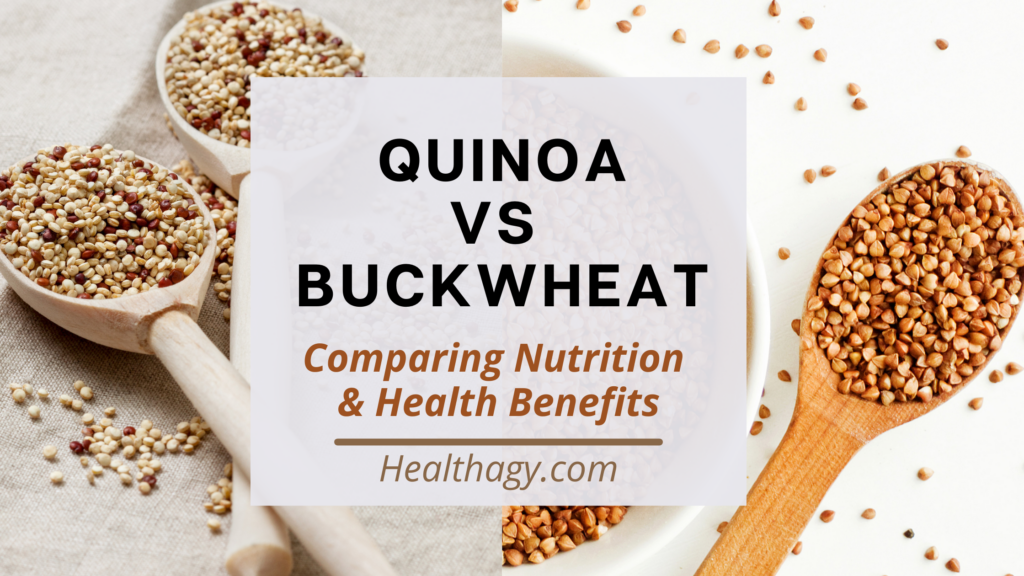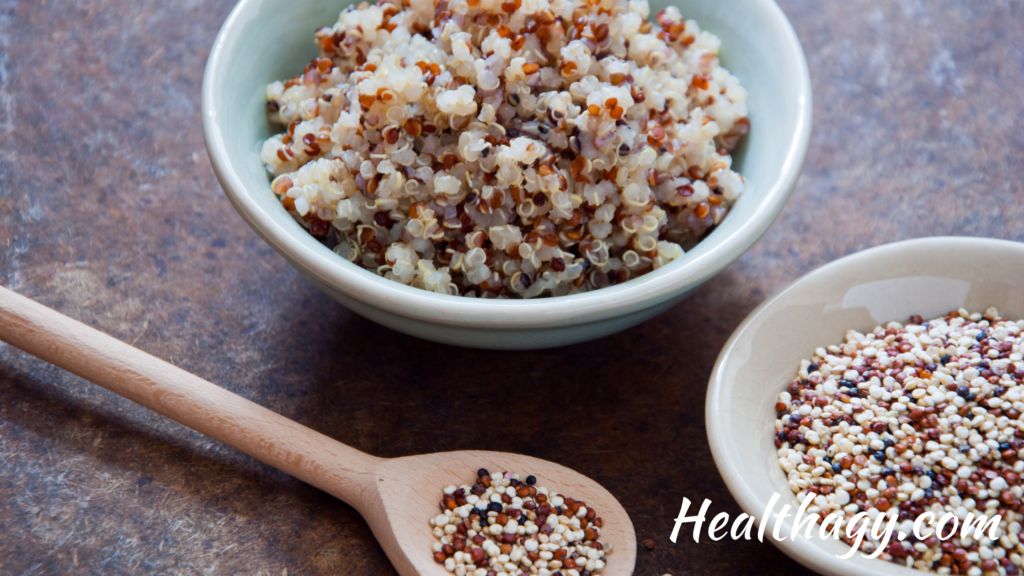
Quinoa and buckwheat are two very popular whole grains for people choosing to eat gluten-free diets and for people with celiac disease or gluten intolerance. Quinoa and buckwheat are both naturally gluten-free and make a great addition to a healthy diet. Which leaves the question: What are the differences between quinoa and buckwheat? And which one is healthier and more nutritious for you?
Key Differences Quinoa vs Buckwheat
The main difference between quinoa vs buckwheat is quinoa contains more protein, fiber, fat, and vitamins than buckwheat does. Quinoa also has more calories.
One cup of cooked quinoa contains 222 calories, 5.2 grams of dietary fiber, and 8.1 grams of protein. One cup of cooked buckwheat contains 155 calories, 2.5 grams dietary fiber, and 5.7 grams of protein.

What is Quinoa?
Quinoa is an ancient grain; while technically a seed, it is classified as a whole grain, often referred to as a “pseudo-grain,” it has been around for thousands of years. Quinoa is a popular grain for people who eat a plant-based diet and those on gluten-free diets or have a gluten sensitivity. Quinoa is a good source of protein with high fiber content and contains various vitamins, minerals, and antioxidants, all of which make it a “superfood.”
One thing that sets quinoa aside from other plant sources is that it is a complete protein containing all nine essential amino acids. One cup of cooked quinoa contains approximately 8.1 grams of protein. In comparison, one cup of cooked brown rice contains about 5 grams of protein and is an incomplete source of protein.
Quinoa Taste
Quinoa has a slightly bland yet nutty flavor. You can find quinoa seeds in a few different varieties, such as black quinoa, red quinoa, and white quinoa.
Quinoa can be ground into a very fine flour and used to make various pasta, bread, and other gluten-free products, making it a great gluten-free alternative.
How to Use Quinoa
Quinoa goes great with vegetables and proteins such as chicken and fish. It also can be a great alternative to pasta, rice, and lentils.
If you have Celiac disease or are on a strict gluten-free diet, don’t forget to look for the certified gluten-free stamp.

What is Buckwheat?
Like quinoa, buckwheat is an ancient grain that has been cultivated for thousands of years. Contrary to how its name might sound, buckwheat is naturally gluten-free, is not a wheat, and is not even an actual grain as wheat is. While buckwheat is considered to be a whole grain as it is rich in complex carbohydrates, it is technically a fruit seed, making it a pseudograin.
Over time, buckwheat has maintained its place as a popular food in Asian and Eastern European countries. It became less popular in America over the last century with an uptick in the production and consumption of wheat and corn products. However, in recent years buckwheat has begun to make a comeback, particularly for people looking for a more balanced and healthy diet and alternatives to wheat and corn products.
Like quinoa, buckwheat is also a great source of high-quality protein, although it contains slightly less protein per serving at 5.7 grams than quinoa at 8.1 grams of protein. Like quinoa, buckwheat is also a complete protein.
Buckwheat Taste
Buckwheat has a soft and chewy texture, with a more robust nutty and slightly bitter flavor than other common grains you may be used to, such as rice and oats.
How to Use Buckwheat
One of the most common ways to eat buckwheat seeds, commonly called buckwheat groats, is to eat them as a form of porridge, similar to oatmeal. Buckwheat groats are also commonly eaten as a substitute for white rice or quinoa and pair well with salads, vegetables, and proteins. Buckwheat can also be ground into buckwheat flour, which can be used for making favorites such as buckwheat pancakes and other baked goods.
If you purchase baked goods made with buckwheat and are gluten-free, always check the ingredients carefully, as some buckwheat foods are made with wheat flour.
Nutritional Profile Quinoa vs Buckwheat
Below are the key nutritional values of one cup of quinoa (cooked) and one cup of buckwheat (cooked).
| 1 cup of quinoa (cooked), % Daily Value | 1 cup of Buckwheat (cooked), % Daily Value | |
| Calories | 222 | 155 |
| Total Carbohydrate -Dietary fiber -Sugar – Added Sugars | 39.4 g, 13% 5.2 g, 19% 1.6 g, 3% 0 g | 33.5 g, 11% 4.5 g, 16% 1.5 g, 3% 0 g |
| Protein | 8.1 g, 16% | 5.7 g, 11% |
| Total Fat Saturated Fat | 3.6 g, 5% 0.4 g, 2% | 1 g, 1% 0.2 g, 1% |
| Vitamin D | 0 mcg | 0 mcg |
| Calcium | 31.5 mg, 2% | 11.8 mg, 1% |
| Iron | 2.8 mg, 15% | 1.3 mg, 7% |
| Potassium | 318.2 mg, 7% | 147.8 mg, 3% |
| Phosphorus | 281.2 mg, 22% | 117.6 mg, 9% |
| Magnesium | 118.4 mg, 28% | 85.7 mg, 20% |
| Zinc | 2 mg, 18% | 1 mg, 9% |
| Vitamin C | 0 mg | 0 mg, 0% |
| Vitamin E | 1.2 mg, 8% | 0.2mg, 1% |
| Manganese | 1.2 mg, 51% | 0.7 mg, 29% |
| Selenium | 5.2 μg, 9% | 3.7 μg, 7% |
| Thiamin (Vitamin B1) | 0.2 mg, 16% | 0.1 mg, 6% |
| Riboflavin (Vitamin B2) | 0.2 mg, 16% | 0.1 mg, 5% |
| Niacin (B3) | 0.8 mg, 5% | 1.6 mg, 10% |
| Vitamin B6 | 0.2 mg, 13% | 0.1 mg, 8% |
| Folate (B9) | 77.7 μg, 19% | 23.5 μg, 6% |
They are both technically seeds and nutritionally considered to be pseudo-grains, meaning although they are seeds, nutritionally, they are similar to cereal grains.
Nutritional and Health Benefits of Buckwheat and Quinoa
Quinoa and buckwheat share similar nutritional benefits. While in many instances, quinoa contains more of the same nutrients.
Rich Source of Protein & Fiber
Quinoa and buckwheat are both a good source of fiber and high-quality complete plant protein, with buckwheat containing 5.7 grams of protein per one cup of cooked groats and quinoa containing 8.1 grams of protein. Fiber helps to support digestive health, and protein helps build muscles and manage your appetite.
Low Glycemic Index
When it comes to glycemic index, which measures how a food increases the blood glucose level, quinoa and buckwheat are both considered low glycemic index foods. Foods with a lower GI will cause a slower and lower rise in blood sugar levels as the fiber and protein help slow the digestion process, making them a good option for many diabetics-but always consult your doctor.
High in Lysine
Buckwheat and quinoa are both high in the essential amino acid lysine, with buckwheat containing 14% of the daily recommended value and quinoa containing 21%.
Omega-3 Fatty Acids
Buckwheat and quinoa are healthy sources of omega-3 fatty acids, with buckwheat containing about 24 mg per one cup serving and buckwheat about 28 mg per one cup serving. Omega-3 fatty acids may help lower risk of heart disease and reduce the risk for other chronic diseases, as well as help reduce inflammation and reduce the risk of cancer.
Heart Health
Buckwheat and quinoa may support heart health and provide cardiovascular benefits. Buckwheat and quinoa are excellent sources of magnesium. Magnesium helps relax blood vessels and improve circulation. Buckwheat contains about 20% of the DV and quinoa about 28% per one cup serving. The fiber in both seeds also helps support healthy blood sugar and cholesterol levels, supporting heart health.
Lower Cholesterol Levels
Regularly eating buckwheat and quinoa has been shown to help support reducing total cholesterol, LDL cholesterol, and triglycerides.
Antioxidant Properties
Quinoa and buckwheat have been shown to boost the body’s antioxidant power, as they are both loaded with free-radical-fighting phytochemicals. Buckwheat, in particular, is known for being rich in the antioxidant plant compounds rutin, quercetin, vitexin, and D-chiro-inositol, all of which help provide it with its disease-fighting power.
Healthy Weight Management
Quinoa and buckwheat are both insoluble fiber, meaning they help increase the feeling of being full after eating, and help you feel fuller for longer, which can help support weight loss efforts.
Key Takeaways
Quinoa and buckwheat offer similar nutritional and health benefits; you can’t go wrong choosing either one! While quinoa has a slight advantage in providing a bit more nutrition per serving, they both are excellent choices for your health. A healthy diet contains a variety of whole grains, so try rotating both into your diet for variety and taste.
Karla Kueber is a Certified Evidence Based EFT Practioner and Health Coach, with a double Masters Degree in Education. She works with people to overcome emotional eating, curb cravings, and overcome resistance to eating new healthy foods. You can learn more about coaching with her here.